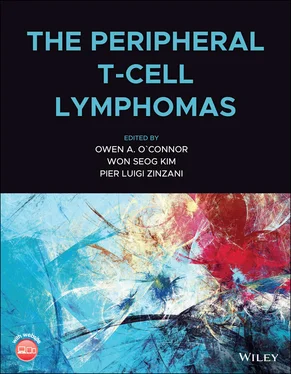Mamiko Sakata‐YanagimotoDepartment of Hematology, Faculty of Medicine, University of Tsukuba Hospital, Tsukuba, Japan, and Graduate School of Comprehensive Human Sciences, University of Tsukuba, Tsukuba, Japan
Ahmed SawasCenter for Lymphoid Malignancies, Columbia University Medical Center, New York, NY, USA
Julia ScarisbrickDepartment of Dermatology, University Hospital, Birmingham, UK
Luigi ScottoCenter for Lymphoid Malignancies, Columbia University Medical Center, New York, NY, USA
Jennifer ShingletonDuke Cancer Institute, Center for Genomic and Computational Biology, Duke University, Durham, NC, USA
Raksha ShresthaGraduate School of Comprehensive Human Sciences, University of Tsukuba, Tsukuba, Japan
Andrei ShustovDivision of Hematology, Department of Medicine, University of Washington, Seattle, WA, USA; Clinical Research Division, Fred Hutchinson Cancer Research Center, Seattle, WA, USA; and Seattle Cancer Care Alliance, Seattle, WA, USA
Tetiana SkrypetsDepartment of Surgical, Medical and Dental Sciences Related to Transplant, Oncology and Regenerative Medicine, University of Modena and Reggio Emilia, Reggio Emilia, Italy
Craig R. SoderquistDivision of Hematopathology, Department of Pathology and Cell Biology, Columbia University Irving Medical Center, New York, NY, USA
Robert N. StuverDepartment of Medicine, Beth Israel Deaconess Medical Center, Boston, MA, USA
Ritsuro SuzukiDepartment of Oncology and Hematology, Shimane University Hospital, Izumo, Japan
Kensei TobinaiDepartment of Hematology, National Cancer Center Hospital, Tokyo, Japan
Claudio TripodoTumor Immunology Unit, Department of Health Sciences, University of Palermo, Palermo, Italy, and Histopathology Unit, FIRC Institute of Molecular Oncology, Milan, Italy
Lorenz TruempeDepartment of Hematology and Medical Oncology, University Medical Center Goettingen, Goettingen, Germany
Sean WhittakerGuy’s and St Thomas’ National Health Service Foundation Trust, London, UK
Mina XuDepartment Pathology, Yale University School of Medicine, New Haven, CT, USA
Amulya YellalaDivision of Oncology‐Hematology, Department of Internal Medicine, University of Nebraska Medical Center, Omaha, NE, USA
Anas YounesDepartment of Medicine, Memorial Sloan Kettering Cancer Center, New York, NY, USA
Jasmine ZainDepartment of Hematology/Hematopoietic Cell Transplantation, City of Hope Medical Center, Duarte, CA, USA
Pier Luigi ZinzaniIRCCS Azienda Ospedaliero‐Universitaria di Bologna Istituto di Ematologia “Seràgnoli”, Dipartimento di Medicina Specialistica, Diagnostica e Sperimentale Università degli Studi, Bologna, Italia
About the Companion Website
Don’t forget to visit the companion web site for this book:
www.wiley.com/go/OConnor/Peripheral_T‐cell_Lymphomas 
There you will find valuable materials, including:
Figures and Tables from within the book
Scan this QR code to visit the companion website:

Part I Biological Basis of the Peripheral T‐cell Lymphomas
1 The Fundamentals of T‐cell Lymphocyte Biology
Claudio Tripodo1,2 and Stefano A. Pileri3
1 Tumor Immunology Unit, Department of Health Sciences, University of Palermo, Palermo, Italy
2 Histopathology Unit, FIRC Institute of Molecular Oncology, Milan, Italy
3 Hematopathology Division, European Institute of Oncology, IRCCS, Milan, Italy
The natural diversity of T cells in normal immune system functions contributes – in part – to the diversity of T‐cell malignancies.
CD4‐positive T lymphocytes, also called T helper (Th) cells, are divided into a diverse repertoire of T lymphocytes (e.g. Th1, Th2, and Th17), in part defined by the cytokine profile they elaborate.
Th1 and Th2 lymphocytes can also be classified based on the expression of the transcription factors T‐bet and GATA3. These factors can be prognostic in peripheral T‐cell non‐Hodgkin lymphomas derived from these cells (with GATA3 being associated with a poor prognosis).
The T‐cell system is conventionally regarded as an enabler of diverse compartments, which correspond to different steps of differentiation and functional subsets of mature cells taking part in the immune response in the peripheral lymphoid and non‐lymphoid tissues.
In this chapter, we give a overview of the T‐cell system, more functionally than anatomically oriented, to reflect its extreme plasticity. This plasticity is thought to lie at the heart of the diversity of T‐cell malignancies now recognized by the World Health Organization.
General View of the Differentiation and Function of T Lymphocytes
The immune system can be classified into two basic component: (i) the innate immune system, and (ii) the acquired immune system. The innate immune system is considered to be relatively agnostic to any specific antigen, and is often described as invariant. The innate immune response is the first line of defense, and typically exhibits limited specificity. Examples of innate immune response may include phagocytosis by macrophages, barriers to infection provided by the skin and tears, natural killer and mast cells, and complement‐mediated cytolysis. In contrast, the adaptive (or sometimes called acquired ) immune response develops in response to specific antigen, being “custom” designed for the antigen in question. It usually occurs later in the immune response, and has the ability to recall the response to past infections. Components of a functioning acquired immune response might involve antigen‐presenting cells presenting antigen or T cells, the activation of specific T cells which would signal to B cells enlisting their engagement in the response and the production of highly specific antibody capable of binding specific antigen. T and B lymphocytes are the major types of lymphocytes found in the human body, where they can constitute 20–40% of all white blood cells, with only about 2–3% being found in the peripheral circulation, the remainder being localized to various lymphoid organs (lymph nodes, spleen, submucosal tissue). Remarkably, the total mass of lymphocytes in the body can approximate the mass of the brain and liver.
As shown in Figure 1.1[1], T lymphocytes arise from a bone marrow precursor, which undergoes maturation and functional orientation in the thymus. Antigen‐specific T cells mature in the thymic cortex, where the elements recognizing self‐peptides and major histocompatibility antigens expressed by cortical epithelial cells and thymic nurse cells are eliminated via apoptosis. Failure to eliminate those T cells recognizing self‐peptides is thought to give rise to a host of autoimmune disorders.

Figure 1.1 Schematic overview of T‐cell ontogeny and differentiative trajectories.
Читать дальше















